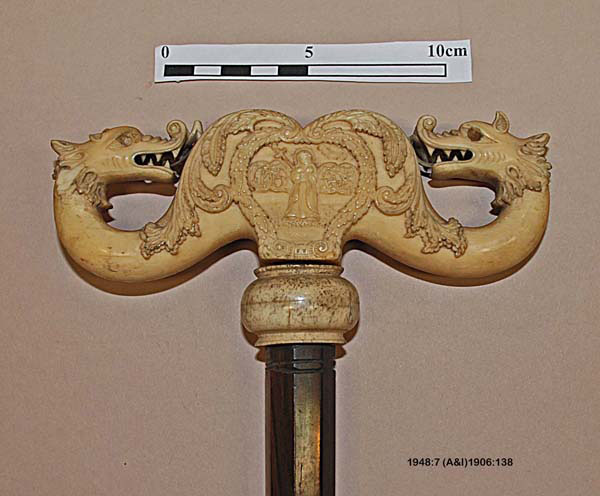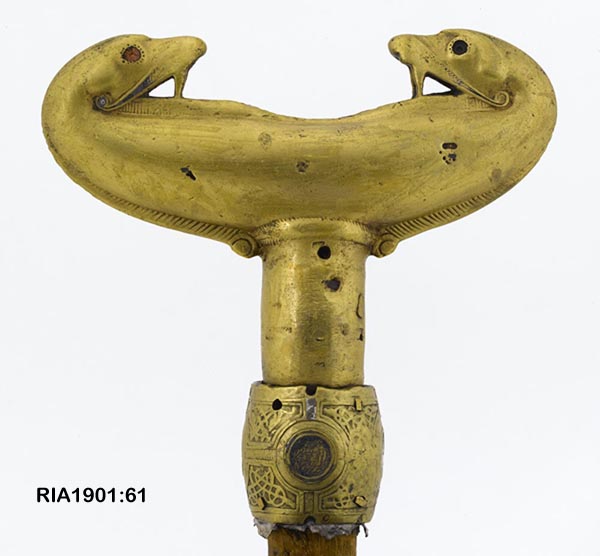Purchased 1906
Two Tau Croziers: Coptic or Armenian?
These two tau croziers are unique in the National Museum of Ireland’s collection and are recorded as being Coptic in origin. They were purchased by the museum in 1906 at auction at Sotheby’s in London. Both were transferred from the Art and Industry Division to the Irish Antiquities Division in 1948.
By Sharon Weadick
The entries in the museum’s register read:
Bronze Tau Crozier - 1948:6 (A&I 1906:66)
“Tau cross; bronze gilt head, formed as two serpent affrontés; the staff in three parts (screwed together and to the head) of ebony carved with interlacing, inlaid with bone, and mounted with silver” and was “used by the bishops in the Coptic church.”
Ivory Tau Crozier - 1948:7 (A&I 1906:138)
“Tau cross carved, carved ivory head - two serpent affrontés on one side, the crucifixion on the other the Blessed Virgin (Mater Dolorosa); the shaft of ebony in three lengths screwed together; bone ferrule. Christian Coptic.”
The head of both croziers takes the form of a tau cross carved with two serpent heads on either side. The symbolism of the serpents and the tau cross is a biblical reference to a passage from the Book of Numbers (21:4-9). Moses makes a bronze snake and mounts it on a pole to cure the Israelites of snake bites inflicted on them by the “fiery serpents” as punishment for complaining against Yahweh (God).
What is a crozier?
A crozier is a hooked staff carried by bishops or abbots as a symbol of pastoral office and authority. In Western Christianity, the crozier head is usually shaped like a shepherds crook; in the Eastern Church the head is more commonly Tau-shaped (Lucas, 1973, 114).

Fig. 2: Ivory Tau Crozier
What is a tau cross?
Allegedly derived from the Greek capital ‘T’, the origins of the tau cross, crux ansata or the cross of St. Anthony can also be traced back to the ancient Egyptian hieroglyphic Ankh, meaning the “key of Life” or “the Key of the Nile”. In the 3rd century A.D. the tau cross became affiliated with St. Anthony, one of the founding fathers of the ascetic monastic movement within the Coptic Church.
Questioning the origins of the two croziers
Unfortunately, the information in the museum’s registers is rather scant, especially regarding the exact find place and date of the croziers. It is likely that both descriptions were transcribed from Sotheby’s catalogue after they were acquired by the museum.

Fig. 3: T-shaped crozier
While carrying out research for this article it became apparent that tau-head croziers are, in fact, quite rare. There is one tau crozier (RIA1901:61) from Ireland on exhibition in the museum. However, recent research has shown that it is more likely to be a T-shaped crozier fitting rather than a tau crozier head (Murray, 2007, 80-81). Searches for ‘Coptic tau croziers’ in the on-line catalogues for the British Museum, the Metropolitan Museum, the Louvre and the Victoria and Albert Museum (V&A) all failed to produce any results.
Coptic or Armenian?
On examining the croziers two things became immediately clear: the croziers appear to be no more than a few hundred years old, and the script of the inscriptions does not appear to be Coptic.
On further examination it became clear that they are remarkably similar to the 17th and 18th century tau croziers from Armenia in the V&A collection. They bear a particular resemblance to the ivory tau crozier head and the silver tau crozier which belong to the V&A’s Armenian collectionLinks to external website. Like the two tau croziers in the Museum collection, the tau croziers/ crozier heads from the V&A are also formed by two serpent affrontés curling or facing up rather than down as sometimes seen on other tau crozier heads.
It now seems that the Museum register entries for the croziers were incorrect and that they cannot be Coptic in origin. The details regarding the croziers’ origins appear to have gone unchecked after they were acquired by the museum – leaving this error in their records undetected until now. Further research will be required to confirm whether or not the two tau croziers are of Armenian origin and date. The Museum has a very small collection of ten Armenian objects. However, this recent discovery could greatly enrich that collection.
Learn more…
These objects are not currently on public display as they are part of the museum’s reserve collections.
European and Irish croziers are on display in the Medieval Ireland exhibition on the first floor in the National Museum of Ireland – Archaeology on Kildare Street, Dublin 2.
Web Resources
Armenian Pastoral Staff from People of Ar Blog
Stone Pieces from Cairo’s Coptic Museum
Victoria & Albert Museum's Ivory Armenian Tau Head
Victoria & Albert Museum's Silver Armenian Tau Head
References
Healey, T. 1977. ‘The symbolism of the Cross in Sacred and Secular Art’ in Leonardo, 10, No. 4 (Autumn), 289-294.
Lucas, A.T. 1973. Treasures of Ireland. Dublin.
Murray, Griffin. 2007. ‘Insular-type croziers: their construction and characteristic’ in R. Moss (ed.), Making and Meaning in Insular Art: proceedings of the fifth international Conference on Insular Art, 79-94. Dublin.
Acknowledgements
With thanks to Mary Cahill curator of the Museum’s Egyptian, Gold and Prehistoric collections for her comments.
Thanks also to Valerie Dowling and Anne Keenan from the Photographic Department for the use of the image of the tau crozier (RIA1901:61).
Location:
Two Tau Croziers: Coptic or Armenian? is located at:
In Storage
Previous artefact:
Next artefact:
